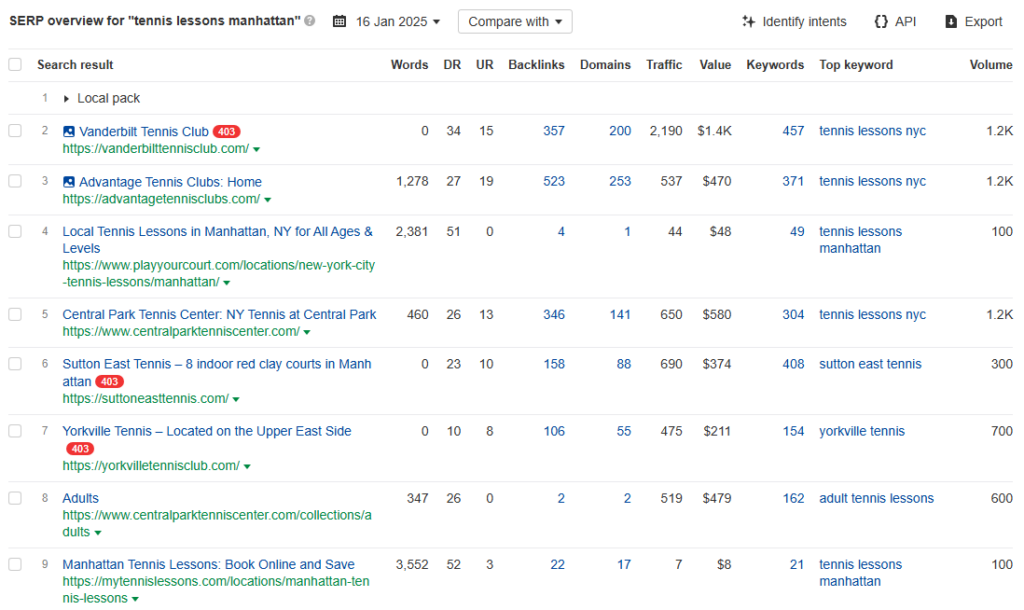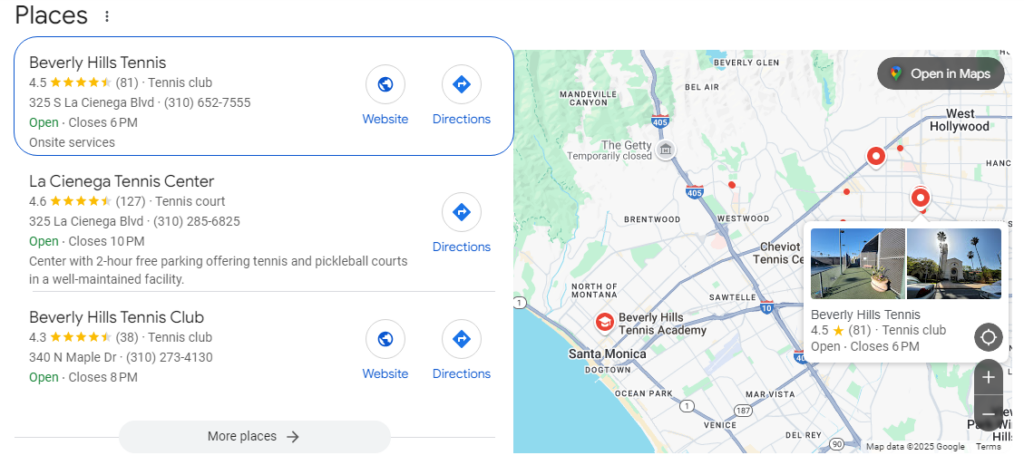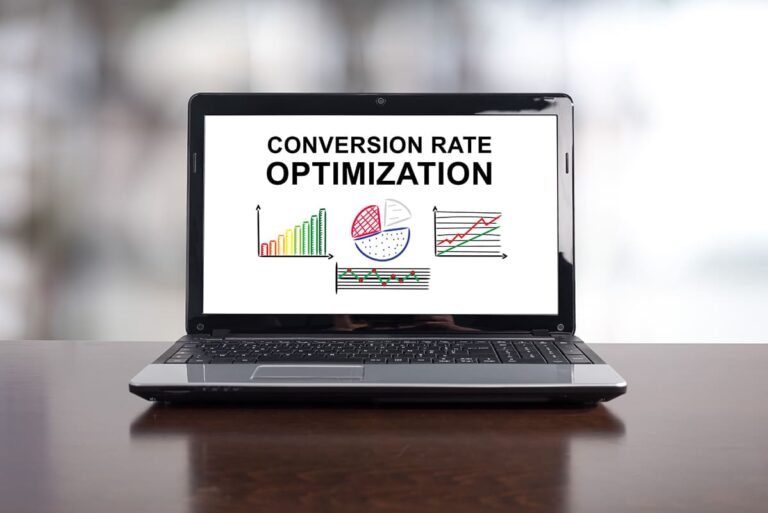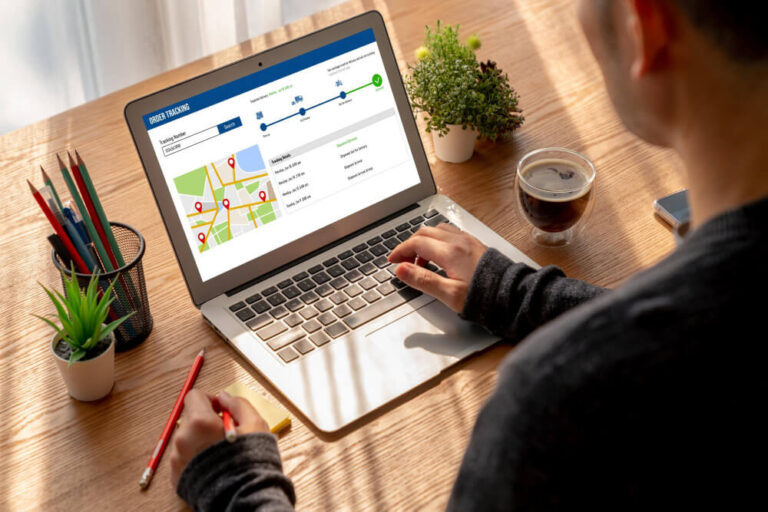Building a successful tennis business takes more than coaching expertise. A strong online presence helps attract new players, retain members, and boost revenue.
Many club owners and coaches find marketing overwhelming because they are unfamiliar with the key terms and strategies that drive results.
This guide explains 25 essential marketing terms, their meaning, and how to use them effectively.
Understanding these concepts will improve your tennis business visibility, engage potential clients, and turn website visitors into paying students.
1. Domain Authority (DA)
Domain Authority (DA) is a score (1-100) predicting a website’s ability to rank in search engines. Higher scores indicate a stronger ranking potential.
DA improves with quality backlinks. It’s a comparative metric, not used by Google, but helpful for assessing website strength against competitors. MOZ developed this metric, and you most likely know about DR (Domain Rating – developed by Ahrefs).
There are others, but the main takeaway is that a higher DA (DR) means more websites are linking to you (so you are popular), making your content rank easier. If we post the same super-optimized article on a DA 5 website and a DA 55 website, in most cases the website with a stronger Domain Authority will outrank the one with smaller DA.
Improve DA by acquiring quality backlinks from reputable sources, such as local sports blogs or partner organizations. You can also use our sister company We Dot Media and have our team outreach for high-level backlinks, without you having to do the work.
2. Keyword Optimization
Keyword optimization involves selecting and strategically using relevant search terms in website content, meta tags, and headings to improve search engine visibility.
Effective optimization includes natural keyword placement, avoiding overuse, and aligning with user intent to attract the right audience and increase organic traffic.

Here are for instance the top-ranking websites for “tennis lessons Manhattan“, ideal for a tennis club that is within driving distance from Manhattan. Ranking high for this “service + location” type of keywords also works when people who are in Manhattan search for “tennis lessons near me”.
This is why we don’t write content trying to rank for this exact query (keyword) as Google has finally gotten smart enough to use the location of the person who searches and show “near me” places based on what they are looking for (restaurants, IVF clinics, bakeries, or, in our case, tennis clubs).
If you don’t mind geeking out a little more, let’s read the table above and see what else we can find out:
- words – how many words the ranking page has. As a general rule in my content marketing strategies: gauge what top rankers are doing and do the same. If most of the top 10 pages have 500-600 words written, you can get by with a shorter article. If most of them have huge wordcount (like this article for instance), unleash your inner Balzac, because there’s little chance you’ll rank with a few hundred words.
- DR and UR – we already explained what Domain Rating is, UR means URL Rating, which allows you to gauge how strong a certain page is, from the backlinks point of view. For more competitive keywords, you’ll try to get a higher UR, so that you can rank better.
- Backlinks and Domains – how many pages are linking to the ranking page and how many domains are linking to it.
- Traffic is an ESTIMATE (all Ahrefs, Semrush, Ubersuggest etc. traffic stats are estimate, unless they are tied to your Google Search Console). Even so, very useful data, this is why we still take it into account.
- Value – another estimate taking into account average CPC (Cost Per Click) data for certain keywords.
- Top keyword – the main query the page ranks for (sometimes it’s not the one we have thought it would). You can get a great list of potential new keywords to create content around and valuable insights on the amount of estimate searches in a month – the last column: Volume).
3. On-Page SEO
On-Page SEO refers to optimizing individual web pages to improve search engine rankings and user experience. This includes using relevant keywords in titles, meta descriptions, headers, and content, optimizing images, improving page speed, and ensuring mobile-friendliness.
Strong On-Page SEO helps search engines understand the page’s relevance to user queries.
In terms of your tennis activity, working on your on-page optimization is like doing clinics to improve groundstrokes, volleys, and serves. While you can fare well as a tennis player, even by being talented enough, there is still a limit.
A top-rated player will have to work endlessly to perfect technique, just like your tennis SEO will work on your website to make sure it’s in great shape.
4. Off-Page SEO
Off-Page SEO includes actions outside a website to improve its search rankings and authority. This primarily involves building high-quality backlinks, increasing brand mentions, leveraging social media, and engaging in guest blogging.
Strong Off-Page SEO signals to search engines that a site is credible, valuable, and worth ranking higher.
5. Local SEO
Local SEO focuses on optimizing a business’s online presence to attract local customers. It involves optimizing Google Business Profile, using location-based keywords, building local citations, and gathering positive reviews. Effective Local SEO helps tennis clubs and coaches appear in local searches, like “tennis lessons near me,” driving more nearby clients.
Since proximity (how close the searcher is to the location) is the 1st ranking factor, even small tennis clubs or private coaches can outrank HUGE academies just by leveraging local SEO.
If you don’t want to do it yourself, you can get Tennis Marketing Pros to handle this work. For just $2,000 a month, we ensure your website and GBP are in great standing, with new articles and backlinks to dominate your area.
6. Google Business Profile (GBP)

Google Business Profile (GBP) is a free tool that allows businesses to manage their online presence on Google Search and Maps. It includes details like business name, location, hours, reviews, and photos.
Optimizing GBP improves local visibility, helps attract nearby customers, and enhances credibility through reviews and engagement.
7. Mobile Responsiveness
Mobile responsiveness ensures a website adapts seamlessly to different screen sizes, providing an optimal user experience on smartphones and tablets. A responsive site loads quickly, adjusts layouts dynamically, and improves navigation.
Since Google prioritizes mobile-friendly websites in rankings, optimizing mobile responsiveness enhances visibility, engagement, and conversion rates.
8. Landing Page
A landing page is a standalone web page designed for a specific marketing goal, such as capturing leads or promoting a service. It features a clear call-to-action (CTA), minimal distractions, and persuasive content. Well-optimized landing pages improve conversions by guiding visitors toward booking lessons, signing up, or making inquiries.
Create landing pages for specific campaigns, such as summer camps or private coaching, with a clear call-to-action (CTA).
Read more about converting visitors into clients: 15 Conversion Rate Optimization Tips for a Tennis Club Website.
9. Content Marketing
Content marketing involves creating and sharing valuable, relevant content to attract and engage a target audience. This includes blog posts, videos, social media updates, and newsletters.
For tennis clubs and coaches, effective content marketing builds trust, showcases expertise, and drives potential clients to book lessons or join programs.
10. Call-to-Action (CTA)
A Call-to-Action (CTA) is a prompt that encourages users to take a specific action, such as booking a lesson, signing up for a newsletter, or contacting a coach. Effective CTAs use clear, compelling language like “Book Your Free Trial Lesson Today” to drive conversions and engagement.
11. Lead Magnet
A lead magnet is a free resource offered in exchange for a potential client’s contact information. Examples include a tennis training guide, a free lesson, or a workout plan. Effective lead magnets provide value, build trust, and help grow an email list for future marketing efforts.
12. Social Media Engagement
Social media engagement measures interactions like likes, comments, shares, and direct messages on platforms such as Instagram, Facebook, and Instagram. High engagement boosts visibility, strengthens relationships with potential clients, and increases brand trust.
Tennis clubs and coaches can enhance engagement by posting valuable content, responding to comments, and encouraging discussions.
13. Hashtag Strategy
A hashtag strategy involves using relevant and targeted hashtags to increase content visibility and reach on social media platforms. For tennis coaches and clubs, using hashtags like #TennisLessons, #JuniorTennis, and #TennisTraining helps attract potential clients.
A balanced mix of popular, niche, and location-based hashtags improves discoverability and engagement.
14. User-Generated Content (UGC)
User-Generated Content (UGC) is content created by clients, students, or fans that showcases their experience with a business. For tennis clubs and coaches, this includes photos, testimonials, or training videos shared by players.
Encouraging UGC builds trust, boosts engagement, and provides authentic marketing material for social media and websites.
15. Influencer Marketing
Influencer marketing involves partnering with individuals who have a strong online following to promote a business or service.
For tennis coaches and clubs, collaborating with tennis influencers, local athletes, or popular trainers can increase brand visibility, attract new clients, and build credibility through authentic endorsements and shared content.
16. Google Ads
Google Ads is a paid advertising platform that allows businesses to display targeted ads on Google Search, YouTube, and other partner sites.
Tennis clubs and coaches can use Google Ads to attract new clients by bidding on keywords like “tennis lessons near me,” ensuring their services appear in relevant searches.
17. Facebook & Instagram Ads
Facebook & Instagram Ads are paid promotions that allow businesses to target specific audiences based on demographics, interests, and behaviors. Tennis clubs and coaches can use these ads to reach potential clients in their area, promote lessons or programs, and drive engagement with compelling visuals, videos, and strong calls-to-action.
18. Pay-Per-Click (PPC)
Pay-Per-Click (PPC) is an online advertising model where businesses pay a fee each time someone clicks on their ad. Tennis clubs and coaches can use PPC campaigns on Google or social media to drive targeted website traffic, attracting potential students actively searching for lessons or programs.
19. Retargeting Ads
Retargeting ads help you reach people who visited your website but didn’t take action, like booking a lesson. By showing targeted ads, you can remind potential clients about your services, highlight special offers, and use testimonials to encourage them to sign up and take the next step.
20. Email Automation
Email automation allows you to send scheduled or triggered emails to potential and existing clients without manual effort. You can use it to follow up with new leads, send reminders for upcoming lessons, or share promotions. Automating emails keeps your audience engaged and helps convert prospects into loyal students.
21. Conversion Rate
Conversion rate is the percentage of visitors who take a desired action, such as booking a lesson, signing up for a newsletter, or contacting you. Optimize your website with clear calls-to-action, compelling offers, and an easy-to-use booking system to improve your conversion rate.
22. A/B Testing
A/B testing compares two webpage versions, ad, or email to see which performs better. You can test different headlines, images, or call-to-action buttons to determine what drives more sign-ups or bookings. This data-driven approach helps you optimize marketing efforts and improve conversion rates.
23. Google Analytics
Google Analytics is a free tool that tracks and analyzes website traffic, helping you understand visitor behavior. You can see where your audience comes from, which pages they visit, and how long they stay. Use this data to improve your website, optimize content, and increase conversions for your tennis programs.
24. Click-Through Rate (CTR)
Click-Through Rate (CTR) measures the percentage of people who click on your ad, email link, or website link after seeing it. A higher CTR means your content is engaging and relevant. Improve your CTR by using compelling headlines, clear calls-to-action, and eye-catching visuals in your marketing campaigns.
25. Customer Lifetime Value (CLV)
Customer Lifetime Value (CLV) estimates the total revenue a client will generate over their relationship with your business. Increasing CLV involves retaining students through quality coaching, offering memberships, and upselling services like private lessons or clinics. A higher CLV means more long-term revenue without constantly acquiring new clients.
Mastering these marketing terms and applying them to your strategy will give you a competitive edge. Whether you’re improving SEO, running targeted ads, or leveraging social media, each tactic plays a role in growing your business. Consistency and data-driven decisions are key to long-term success. Start implementing these strategies today and watch your tennis club or coaching business thrive.



